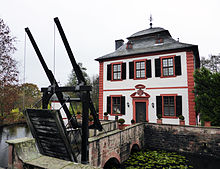Seligenstadt moated castle
The Wasserburg Seligenstadt is a pleasure palace near Klein-Welzheim , a district of Seligenstadt in the Offenbach district in Hesse .
history
The castle is located on the southeastern outskirts of Seligenstadt not far from the Main , west of Klein-Welzheim. It was built in place of an older moated castle . The age of the previous castle cannot be precisely stated, it may be identical to a castrum mentioned in a document in 1266 , which was abandoned after the Palatinate Seligenstadt was built. The moat of the complex is said to go back to the older castle complex. Another building at the same location is said to have been destroyed in the Thirty Years War .
The Seligenstädter Abbot Francis II. Blöchinger let today's surge in his tenure (1695-1715), probably built around 1700 or 1705th It served as a garden house for the early modern courtly festival culture in the garden of the Seligenstadt abbots. A century later, the moated castle came into state ownership through secularization . It has been privately owned since 1972 and has been restored in accordance with the requirements of listed buildings. The moated castle is the starting point of the “Kurmainzer Herz” cultural cycle path in the Rhine-Main regional park .
investment
Although the complex follows the type of a late medieval castle with a moat , drawbridge and four small corner towers, allusions to the fortress architecture common at the time of construction are avoided. However, the two-storey residential building does not have a facade design that is common for pleasure palaces of that time. Small oriel turrets, which it probably had in its original state, are missing from the building today. Above the entrance is the inscription This house is in God's hands / it is named for the moated castle.
The moated castle was still surrounded by a spacious, baroque garden, which has now disappeared.
literature
- Georg Ulrich Großmann : South Hesse. Art guide. Imhof, Petersberg 2004, ISBN 3-935590-66-0 , p. 171.
- Rudolf Knappe: Medieval castles in Hesse: 800 castles, castle ruins and castle sites. 3rd edition Wartberg-Verlag, Gudensberg-Gleichen 2000, ISBN 3-86134-228-6 , p. 412f.
- Ulrich Schütte: The castle as a fortification. Fortified castle buildings from the early modern period. Wissenschaftliche Buchgesellschaft, Darmstadt 1994, ISBN 3-534-11692-5 , pp. 290f.
- Dorothe Trouet: The "moated castle of the abbots" in Seligenstadt. In: Hartmut Hofrichter (Hrsg.): The castle - a cultural-historical phenomenon. Theiss, Stuttgart 1994, ISBN 3-8062-1134-5 (= publications of the Deutsche Burgenvereinigung eV, series B, publications Volume 2 and special issue Burgen und Schlösser ), pp. 119–124.
- Rolf Müller (Ed.): Palaces, castles, old walls. Published by the Hessendienst der Staatskanzlei, Wiesbaden 1990, ISBN 3-89214-017-0 , p. 329.
Individual evidence
- ↑ Rudolf Knappe: Medieval castles in Hesse: 800 castles, castle ruins and castle sites. Gudensberg-Gleichen 2000, p. 412f.
- ↑ Ulrich Schütte: The castle as a fortification. Fortified castle buildings from the early modern period. Darmstadt 1994, p. 291.
- ↑ Ulrich Schütte: The castle as a fortification. Fortified castle buildings from the early modern period. Darmstadt 1994, p. 291; Note 28.
Web links
Coordinates: 50 ° 2 ′ 16.3 ″ N , 8 ° 59 ′ 26.1 ″ E




